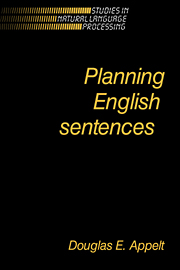Book contents
- Frontmatter
- Contents
- Dedication
- Preface
- 1 Introduction
- 2 An overview of related research
- 3 Representing knowledge about intensional concepts
- 4 Planning to affect an agent's mental state
- 5 Planning illocutionary acts
- 6 Planning surface linguistic acts
- 7 Utterance planning: an example
- 8 Utterance planning: the future
- Notes
- Bibliography
- Frontmatter
- Contents
- Dedication
- Preface
- 1 Introduction
- 2 An overview of related research
- 3 Representing knowledge about intensional concepts
- 4 Planning to affect an agent's mental state
- 5 Planning illocutionary acts
- 6 Planning surface linguistic acts
- 7 Utterance planning: an example
- 8 Utterance planning: the future
- Notes
- Bibliography
Summary
Toward a theory of language generation and communication
A primary goal of natural-language generation research in artificial intelligence is to design a system that is capable of producing utterances with the same fluency as that of a human speaker. One could imagine a “Turing Test” of sorts in which a person was presented with a dialogue between a human and a computer and, on the basis of the naturalness of its use of the English language, asked to identify which participant was the computer. Unfortunately, no natural-language generation system yet developed can pass the test for an extended dialogue.
A language-generation system capable of passing this test would obviously have a great deal of syntactic competence. It would be capable of using correctly and appropriately such syntactic devices as conjunction and ellipsis; it would be competent at fitting its utterances into a discourse, using pronominal references where appropriate, choosing syntactic structures consistent with the changing focus, and giving an overall feeling of coherence to the discourse. The system would have a large knowledge base of basic concepts and commonsense knowledge so that it could converse about any situation that arose naturally in its domain.
However, even if a language-generation system met all the above criteria, it might still not be able to pass our “Turing Test” because to know only about the syntactic and semantic rules of the language is not enough.
- Type
- Chapter
- Information
- Planning English Sentences , pp. 1 - 12Publisher: Cambridge University PressPrint publication year: 1985



